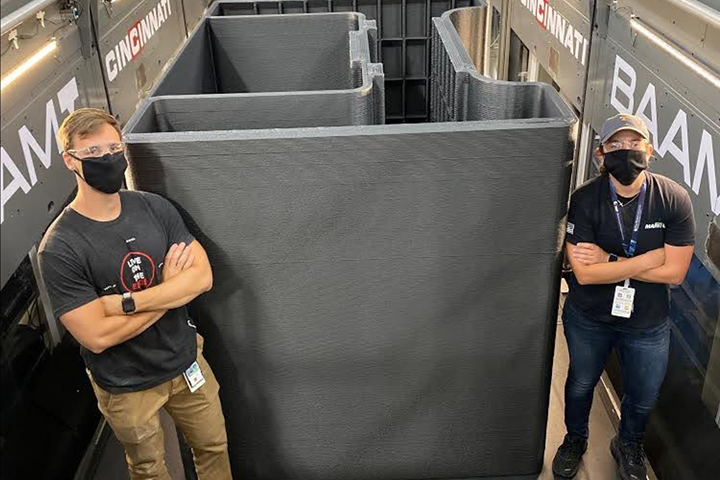ORNL develops 3D-printed composite machine base
In a recently reported project from Oak Ridge National Laboratory, carbon fiber and large-format 3D printing were used to help create a solution for machine tool outsourcing.

Engineers stand inside Oak Ridge National’s Laboratory’s BAAM machine next to a 3D-printed composite machine tool base mold. Source:
Science and technology research and development center Oak Ridge National Laboratory (ORNL, Oak Ridge, Tenn., U.S.) is well-known in the composites industry for its research across composites end markets, and CW has reported a number of projects (such as, most recently, these building facade molds) completed using ORNL’s Cincinnati Inc. (Harrison, Ohio, U.S.) BAAM (Big Area Additive Manufacturing) large-format 3D printer.
According to written and reported by Brent Donaldson, senior editor at ÂÌñÏ×ÆÞ’s sister publication , one of ORNL's latest innovations involved the development of a 3D-printed, carbon fiber composite mold for a concrete machine tool base, built at ORNL’s Manufacturing Demonstration Facility in Tennessee.
Donaldson reports that the ORNL project was part of ACE (which stands for America’s Cutting Edge), a program set up by the U.S. Department of Energy (DOE) and Department of Defense (DOD), in part, to bring more machine tool manufacturing to the United States after years of decline due to offshoring.
The mold, printed on ORNL’s Cincinnati Inc. BAAM machine, is reported to measure 156 inches x 78 inches x 96 inches, made of 20% carbon fiber/ABS. After printing, custom rebar was lowered into the mold before it was filled with 15,000 pounds of concrete to make the end part.
In the case of this project, Donaldson reports, ORNL decided to leave the composite 3D-printed structure in place after cure, so that it served as more of a shell for the concrete part than a mold, but that it could have been removed like a traditional mold.
For the full story behind this project, read “Inside Oak Ridge’s 3D-Printed Machine Tool Moonshot”: .
Related Content
-
Reinforcing hollow, 3D printed parts with continuous fiber composites
Spanish startup Reinforce3D’s continuous fiber injection process (CFIP) involves injection of fibers and liquid resin into hollow parts made from any material. Potential applications include sporting goods, aerospace and automotive components, and more.
-
Composites end markets: New space (2025)
Composite materials — with their unmatched strength-to-weight ratio, durability in extreme environments and design versatility — are at the heart of innovations in satellites, propulsion systems and lunar exploration vehicles, propelling the space economy toward a $1.8 trillion future.
-
Otto Aviation launches Phantom 3500 business jet with all-composite airframe from Leonardo
Promising 60% less fuel burn and 90% less emissions using SAF, the super-laminar flow design with windowless fuselage will be built using RTM in Florida facility with certification slated for 2030.
.jpg;width=70;height=70;mode=crop)





